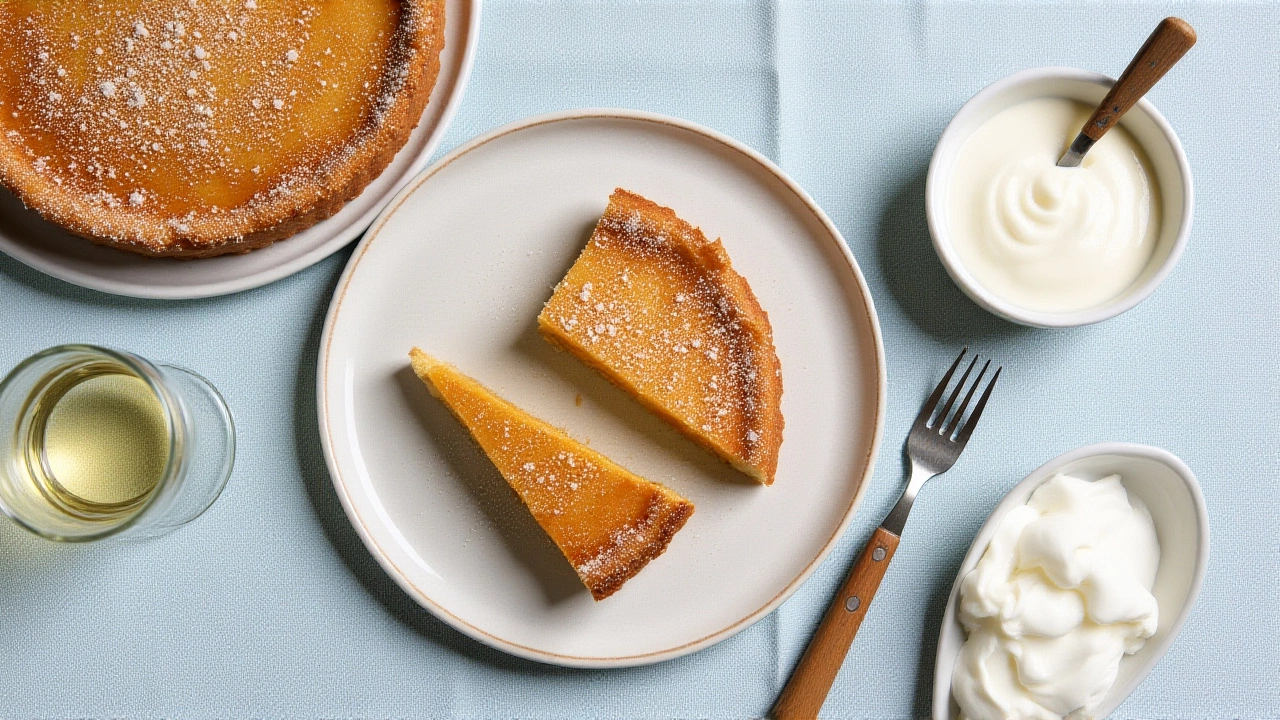Gina DePalma’s Honey and Pine Nut Tart Becomes Spring’s Most Coveted Dessert

When Gina DePalma first published her 'Dolce Italiano: Sweet Dreams of an Italian Life' in 2009, few could have predicted that one tart would outlive its pages — and become a seasonal ritual. Now, nearly 15 years later, her Honey and Pine Nut Tart is making a quiet but powerful comeback across American kitchens and bakeries, celebrated not just for its elegance, but for how perfectly it captures the fleeting sweetness of spring. The recipe, detailed in March 2017 on pancakesandbiscotti.com and further refined in a January 2018 piece on chewingthefat.us.com, has become the unofficial anthem of the season — a dessert that tastes like sunlight on a still morning.
A Tart That Tastes Like April
It’s not just the ingredients. It’s the timing. The honey? Best harvested in early spring when clover, orange blossom, and wildflowers bloom in abundance. The pine nuts? Toasted to a nutty crunch that mirrors the first crisp leaves after winter’s gray. And the citrus zest — lemon or orange — pulls from the last of the winter citrus crops, just as the trees begin to bud. The tart’s magic lies in its contradictions: a buttery, salty caramel base gives way to a silky custard, all crowned with a constellation of toasted pine nuts that crackle under the fork. As pancakesandbiscotti.com noted, the contrast is “beautiful” — not just in texture, but in mood. It’s a dessert that feels both nostalgic and fresh, like remembering your grandmother’s kitchen while standing in a new spring garden.The Recipe, Unpacked
DePalma’s original formula is precise — almost surgical. The dough calls for 2⅓ cups of flour, ⅓ cup of sugar, a pinch of salt, baking powder, and the zest of one citrus fruit, all bound with ¾ cup of cold butter, one egg, an egg yolk, vanilla, and a splash of heavy cream. The filling? Even more deliberate: ⅔ cup (206 grams) of honey, ½ cup of sugar, a teaspoon of salt, 1 cup of butter, ½ cup of cream, another egg and yolk, and precisely 1¼ cups (about 150 grams) of pine nuts. The method is methodical: roll the dough into an 11-inch circle, press it into a 10-inch fluted tart pan, chill it, then prepare the honey caramel by boiling honey, sugar, and salt with butter until it thickens. After cooling 20 minutes, the cream and eggs are whisked in gently, then poured over the pine nuts already scattered in the crust. Bake at 325°F for 30 to 55 minutes — until the crust is golden and the center still jiggles slightly. Let it cool completely. Then, slice. Serve at room temperature. No garnish needed.Modern Twists and Regional Variations
But this isn’t a recipe stuck in amber. In March 2023, savorthebest.com introduced a rosemary-infused version, adding two teaspoons of fresh chopped rosemary to the filling alongside 2 cups of pine nuts and a touch of molasses. “The earthy rosemary,” the site declared, “really brings the flavors together.” The pairing isn’t random. Food historians trace pine nut tarts to Renaissance Sicily, where pine forests supplied the nuts and honey was the only sweetener available before cane sugar arrived. Rosemary, native to the Mediterranean, was already growing wild in those same hills. It’s a revival of tradition, not a reinvention. Even Down Under, the tart has found resonance. Australian pastry chef Darren Purchese, owner of Burch & Purchese Sweet Studio in Melbourne, mentioned a “Pinenut, Rosemary & Honey Tartlet” in his November 2022 Substack newsletter, recalling a dessert that paired pine nuts with grapes and rosemary — a nod to spring’s fleeting fruits. Meanwhile, simplyhoney.com.au offers a version called “AB’s Honey and Pine Nut Tart,” recommending it warm with a dollop of cream and a dusting of icing sugar. No measurements, but plenty of soul.
Why This Matters Now
In a world of over-the-top desserts — rainbow cakes, deconstructed tiramisu, 12-layer croissants — this tart stands out because it asks for nothing but patience and attention. It doesn’t shout. It whispers. And that’s why it’s resonating now. Consumers are tired of gimmicks. They want authenticity. They want flavor that connects them to a season, a place, a memory. The tart’s resurgence isn’t just about taste — it’s about rhythm. It’s a dessert that doesn’t exist until the honey is ready, until the pine nuts are harvested, until the citrus is at its peak. It’s a culinary calendar.What’s Next for the Tart?
Bakeries from New York to Portland are already testing spring menus with DePalma’s tart as their centerpiece. Some are adding lavender. Others are experimenting with almond flour crusts. A few in California are using wildflower honey from local apiaries, labeling each batch with the beekeeper’s name. Meanwhile, culinary schools are reintroducing the recipe into their pastry curricula. The Institute of Culinary Arts in New York added it to its seasonal dessert module last fall. “It’s the perfect teaching tool,” said instructor Elena Ruiz. “It teaches balance. Texture. Restraint. And respect for ingredients.”
Roots in the Soil, Not the Screen
What makes this tart enduring isn’t social media. It’s soil. It’s seasons. It’s the fact that you can’t make it well in December. You have to wait. And that’s rare in a world where everything is available all the time. DePalma didn’t invent the tart — she gave it structure. She gave it a voice. And now, as spring returns, so does the tart — quiet, golden, and perfect.Frequently Asked Questions
Why is this tart specifically a spring dessert?
The tart relies on seasonal ingredients that peak in early spring: floral honey from clover and orange blossoms, which are harvested March through May, and citrus zest from winter crops still lingering into April. Pine nuts, harvested in late winter, are at their freshest and most fragrant as spring begins. The recipe’s balance of sweetness and earthiness mirrors the transition from winter’s heaviness to spring’s lightness.
Can I substitute other nuts for pine nuts?
Pine nuts are irreplaceable for their buttery, almost floral crunch — almonds or walnuts will alter the flavor profile significantly. But if unavailable, toasted sliced almonds are the closest substitute, though they lack the delicate oiliness. Avoid cashews — they’re too soft — and pecans, which are too strong. The tart’s identity hinges on the pine nut’s unique texture and mild taste.
How long does the tart keep, and should it be refrigerated?
Stored at room temperature in an airtight container, the tart lasts up to five days. Refrigeration is unnecessary and can harden the honey caramel, dulling its texture. For longer storage, freeze the whole tart (without glaze) for up to two months. Thaw overnight at room temperature before serving. The custard remains creamy, and the crust stays crisp — if handled gently.
What’s the difference between DePalma’s version and the rosemary variation?
DePalma’s original is pure, minimalist: honey, butter, eggs, pine nuts, and citrus. The rosemary version adds an herbal depth that cuts the sweetness, creating a more complex, savory-sweet profile. The rosemary isn’t overpowering — just enough to echo Mediterranean landscapes where the tart originated. It’s an evolution, not a replacement, and works best with clover honey rather than darker varieties like buckwheat.
Why is this tart gaining popularity now, after 15 years?
After years of sugar-heavy, Instagrammable desserts, diners are craving restraint. This tart delivers richness without excess, elegance without pretense. It’s being rediscovered by home bakers tired of complicated recipes and by chefs seeking authenticity. Social media influencers have also started sharing it under #SpringTart, but the trend is rooted in real taste, not trends — a return to seasonal, ingredient-driven cooking.
Is this recipe truly Italian-American, or just Italian?
The tart’s roots are Sicilian, but DePalma’s version — with its precise measurements, American butter ratios, and emphasis on citrus zest — reflects Italian-American adaptation. Sicilian versions often use ricotta or almond paste; DePalma’s custard base is distinctly American. Her book, published by Ecco Press, helped popularize the recipe beyond immigrant households, making it a bridge between Old World tradition and New World palate.